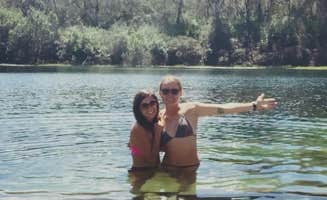Dispersed camping sites in the Ocala National Forest provide free camping near Daytona Beach Shores, Florida for those willing to travel 50-60 miles inland. These primitive camping locations lie within Central Florida's largest forest, covering over 387,000 acres of pine scrub, sand pine, and longleaf pine habitats. Summer temperatures often exceed 90°F with high humidity, while winter nights can drop below 40°F, requiring appropriate seasonal preparation.
What to do
Water activities at riverside sites: At St. Johns River Dispersed Spot, the location next to the river creates opportunities for fishing, kayaking, and wildlife viewing. "The roads to get here are bumpy. Right next to the river and the trees open up so you get a great view of the stars," notes camper Mike D.
Creek exploration: Freak Creek Dispersed Camping offers water access in a remote setting. As camper Adamm A. mentions, "Great place to put a kayak in the water." The creek area provides swimming opportunities during warmer months, though access requires high-clearance vehicles.
Night sky observation: The forest's distance from urban light pollution creates excellent stargazing conditions at most dispersed sites. Forest clearings at riverside locations provide unobstructed views of constellations and meteor showers during clear nights.
What campers like
Seclusion and quiet: The remote nature of these sites appeals to those seeking isolation. Adamm A. describes Freak Creek as "super secluded and quiet. Depending when you stay there's at times people who show up to party and then leave."
Natural swimming areas: Blue Sink offers pristine water features worth the effort to reach. One camper calls it the "most beautiful place to stumble upon," though notes access challenges: "You may need ATV or creative backpacking to get there now."
No reservation requirements: Unlike developed campgrounds, these dispersed camping areas don't require advance booking. This flexibility allows for spontaneous trips during weekdays when fewer visitors are present.
What you should know
Access challenges: Many sites require specialized vehicles and equipment. At Freak Creek, one reviewer warns: "The main road in has huge deep ruts, the other road has a water crossing that was over my bumper on my lifted Mojave... If you don't have 4wd and recovery gear I wouldn't risk it."
Safety considerations: Some forest areas have safety concerns. A review for Lake Dorr mentions: "Spoke to a local that warned of violence, robbery, and killings in this area of the national forest." Research current conditions before selecting your camping location.
Wildlife awareness: Florida panthers have been reported in the forest. A Freak Creek visitor noted: "I talked to another person that use to go out there and said she has seen a panther." Proper food storage and wildlife awareness protocols are essential for safety.
Tips for camping with families
Site selection for vehicle access: Choose locations where you won't risk getting stranded with children. At some sites, as one camper experienced at Lake Dorr, getting "stuck in sand on the way out and had to wait for a tow truck" can quickly turn a family adventure into a stressful situation.
Water access planning: Families appreciating water features should prepare for primitive conditions. No drinking water exists at dispersed sites, requiring 1-2 gallons per person per day plus extra for cleaning and cooking.
Alternative developed options: Families seeking more amenities might consider South Tower Hunt Camp or developed campgrounds within the forest that offer basic facilities while still providing a natural experience at lower cost than coastal accommodations.
Tips from RVers
Size restrictions: Small trailers or truck campers may access some locations, but standard RVs cannot navigate most forest roads leading to dispersed sites. The primitive conditions at Freak Creek prompted one camper to advise: "I would not attempt bringing a camper unless it's really small."
Alternative boondocking: For free camping near Daytona Beach Shores with RV access, consider improved forest roads or hunt camp areas during non-hunting seasons. Always check current Forest Service regulations as accessible areas change seasonally.
Supply planning: With no hookups, water sources, or dump stations at dispersed sites, RVers must be fully self-contained with adequate water, waste capacity, and power for their entire stay plus an emergency reserve.


